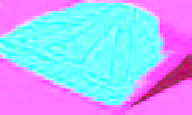Geoscience Reference
In-Depth Information
Table 3.
Facies Associations; their characteristics, sedimentary architectures, geometries and inferred depositional sub-
environment. Letters in coloured boxes in left column refer to facies association coding in Fig. 6. The length of an individual
core slab is 1 metre.
Sedimentary
Architecture
Depositional
sub-environment
Facies Association
Characteristics
Log motif
A
Channel fills
or channel-
belts
Erosive-based, amal gamated
metres-thick bedsets. Fining
upwards or rare coarsening-
to-fining upwards motifs.
Component facies are stratified
and cross-stratified sandstones,
ripple cross-laminated sand-
stones, granule sandstones,
shale-clast conglomerates.
Interbedded mudstone pack-
ages, sometimes comprised of
slumped strata.
Inner fan
distributary
channels
and channel-
belts.
The Channel-
to-Lobe
transition/
Braided
Fan
association
Layered to amalgamated or
scoured bedsets, few to nearly
nine metres-thick. Simple
thinning and fining upward
motifs, or more complex
thickening and coarsening to
thinning and fining upwards
motifs. Component facies
include stratified and cross-
stratified sandstones as well
as rare shale clast conglomer-
ates embedded in hemipelagic
and/or contouritic mudstones.
Interbedded claystones range
from relatively common
to few.
Inner-fan to
mid-fan distri-
butary channels
and channel-
belts as well as
mid-fan
channel-fills
and multilateral
channel storey
sets. Channel to
lobe transitional
areas.
B
The Central
Lobe
association
Layered to amalgamated bedsets
of several metres-thick. Near
symmetrical to asymmetrical
coarsening and thickening to
fining and thinning upwards
motifs as well as irregular bedset
motifs. Component facies are
medium to thick-bedded strat-
ified and cross-stratified, as
well as some 'typical' turbidite
Tabc and massive sandstone
facies. Stratified and massive
sand-stones are commonly
amalgamated whereas hemi-
pelagic mudstones separate
basal Tabc beds and stratified
sandstones.
Channelised/
scoured to
un-channelised
lobes in mid-fan
and outer-fan
settings.
Represents the
central part of
individual lobes
(lobe storeys).
C


















Search WWH ::

Custom Search